|
Greeff
Genealogy Journal
Journal of the Greeff and related families, No
10, June 2008.
Editor: Francois Greeff.
Index of previous editions
Home
About 80% of the Greeff clan lives in South Africa, and most of them understand Afrikaans and English. Roughly 10% of the clan lives in Germany, and they speak German, and understand English. Another 10%, more or less, live in America, where English has not been spoken since the revolution. Because the Greeff Genealogy Journal is also read in New Zealand, Australia, Cuba and Qatar we try to write most of it in English.
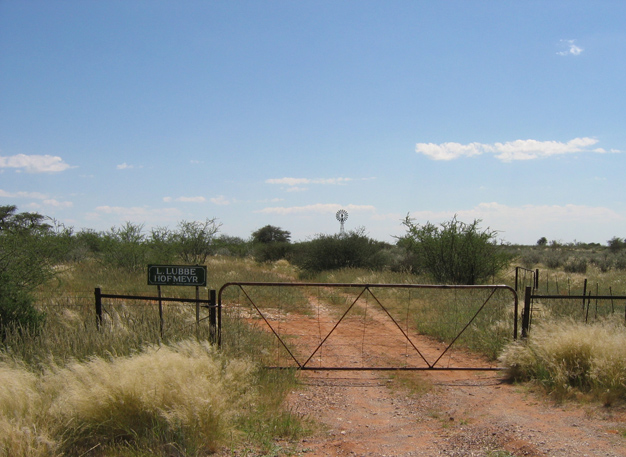
The entrance to the farm and Graveyard at Homeyr, Namibia. (Thanks to Eileen and Marty Russel for the photo)
Contents
Important Notices
1.To go to our web site, please search just one word, Greeff, on Google, and then click on our link (www.Greeff.info). It helps to get our page higher up in the search results, which makes it easier for newcomers to find our site.
2. New telephone number for Francois Greeff : 0044 20 8123 4224 (UK 020 8123 4224). To submit articles to the Greeff Genealogy Journal, email Greeff@Greeff.info.
Greeff Genealogy
Our latest research news: The Greeff DNA Project.
The first Greeff DNA results are coming in, and they look very good! In the first section of the first graph the Y-DNA profiles of three Greeff men are plotted simultaneously, and they are so similar that the three lines lie on top of each other. In the second graph a random person from a different family (Jackson) was chosen to illustrate what happens when there is a mismatch in DNA. Clearly the Jackson line is no match for the typical Greeff profile!
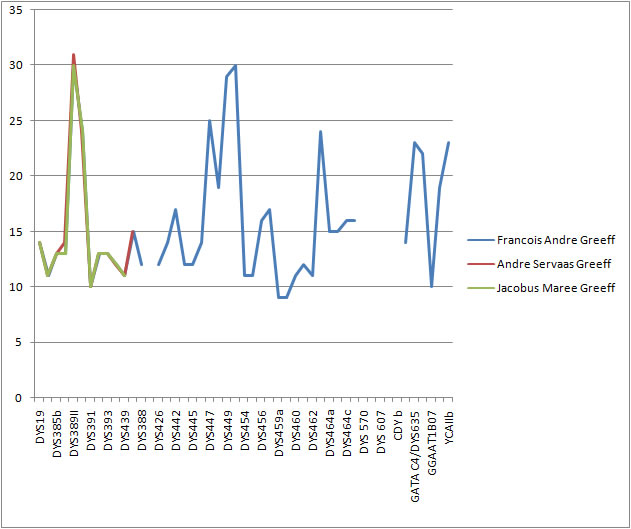
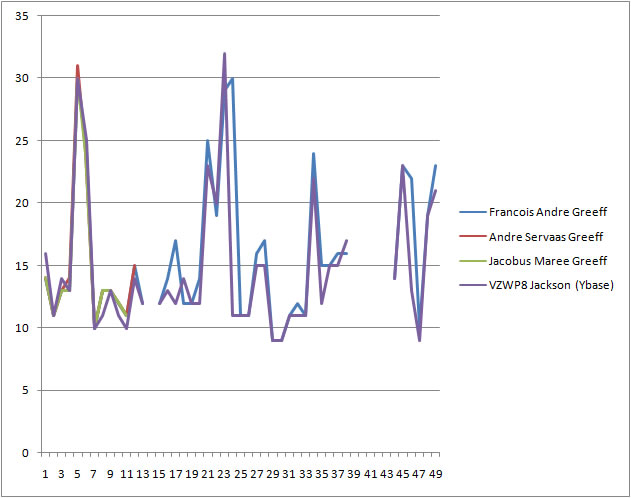
The graphs were plotted using the data from the table below, and the table clarifies the number of comparison points in the graphs. The table also points out the advantage of having a more elaborate test done, because a comparison and match on 43 points is much better than on just one point!
In other words, the more comparison points that match, the better. On viewing Jaco's comparison points (below) it is absolutely clear that his profile is an EXACT match with Francois' profile (both 14,11,13,13,30,24,10,13,13,12,11). This is an excellent indication that it is unlikely that the genetic line between Jaco and Francois was broken at any point or time. The line between the two of them is a long line, because they are cousins, sixteen times removed! Their MRCA (Most Recent Common Ancestor) is Matthys Greeff (born 1711, married to Susanna van den Heever). Matthys is in Jaco's paternal line, eight generations ago. Matthys is in Francois' direct paternal line, also eight generations ago. From Jaco the line runs up eight generations to Matthys, and from there, along a different route, down through eight generations again, to Francois. Eight up plus eight down makes sixteen degrees of separation between Jaco and Francois. These first results of the Greeff DNA project are indeed encouraging, and very exciting!
The family tree at http://www.greeff.info/tng01/register.php?personID=I60&tree=GreeffMainTree&generations= shows the links between Jaco (Number 808, child of No 668) and Francois (No 721, child of No 566).
|
Francois Greeff |
Jaco Greeff |
Andre Greeff |
Random Jackson (Ybase)VZWP8 |
| DYS19 |
14 |
14 |
14 |
16 |
| DYS385a |
11 |
11 |
11 |
11 |
| DYS385b |
13 |
13 |
13 |
14 |
| DYS389I |
13 |
13 |
14 |
13 |
| DYS389II |
30 |
30 |
31 |
30 |
| DYS390 |
24 |
24 |
24 |
25 |
| DYS391 |
10 |
10 |
10 |
10 |
| DYS392 |
13 |
13 |
13 |
11 |
| DYS393 |
13 |
13 |
13 |
13 |
| DYS438 |
12 |
12 |
12 |
11 |
| DYS439 |
11 |
11 |
11 |
10 |
| DYS437 |
15 |
|
15 |
14 |
| DYS388 |
12 |
|
|
12 |
| DYS425 |
0 |
|
|
|
| DYS426 |
12 |
|
|
12 |
| DYS441 |
14 |
|
|
13 |
| DYS442 |
17 |
|
|
12 |
| DYS444 |
12 |
|
|
14 |
| DYS445 |
12 |
|
|
12 |
| DYS446 |
14 |
|
|
12 |
| DYS447 |
25 |
|
|
23 |
| DYS448 |
19 |
|
|
20 |
| DYS449 |
29 |
|
|
32 |
| DYS452 |
30 |
|
|
11 |
| DYS454 |
11 |
|
|
11 |
| DYS455 |
11 |
|
|
11 |
| DYS456 |
16 |
|
|
15 |
| DYS458 |
17 |
|
|
15 |
| DYS459a |
9 |
|
|
9 |
| DYS459b |
9 |
|
|
9 |
| DYS460 |
11 |
|
|
11 |
| DYS461 |
12 |
|
|
11 |
| DYS462 |
11 |
|
|
11 |
| DYS463 |
24 |
|
|
22 |
| DYS464a |
15 |
|
|
12 |
| DYS464b |
15 |
|
|
15 |
| DYS464c |
16 |
|
|
15 |
| DYS464d |
16 |
|
|
17 |
| DYS 570 |
0 |
|
|
0 |
| DYS 576 |
0 |
|
|
0 |
| DYS 607 |
0 |
|
|
0 |
| CDY a |
0 |
|
|
0 |
| CDY b |
0 |
|
|
0 |
| GATA A10 |
14 |
|
|
14 |
| GATA C4/DYS635 |
23 |
|
|
23 |
| TAGA H4 |
22 |
|
|
13 |
| GGAAT1B07 |
10 |
|
|
9 |
| YCAIIa |
19 |
|
|
19 |
| YCAIIb |
23 |
|
|
21 |
If you want to add your DNA profile to the Greeff DNA tree, please email me, and I will tell you how to do it.
My email is Greeff@Greeff.info
Adopted Children and the Greeff DNA Project
There are several people who were adopted into the Greeff family, and many of them, and their descendants, ask why it is important that they should take part in the Greeff DNA project. It is actually more important that adoptees participate than non-adopted people, and there there are two reasons why.
The first of these is that Y-DNA sampling establishes beyond doubt that the medical history of your Greeff relatives is definitely not your medical history. The link between Jaco and Francois (above) means that they can start to examine their common medical history, but if there had been no matching profile, they would know that their medical histories are of no use to each other.To prove that a link exists is as important as proving that a link does NOT exist.
Secondly, it helps to establish precisely what your own medical history is. Y-DNA sampling makes it possible that an adoptee or his descendants can determine the family to which the adoptee belongs, and so place the medical history of that person within grasp.
It has happened that adoptees have been linked to their genetic ancestors through Y-DNA family studies, and today there are specialized web sites for adoptees who seek their genetic roots.
For further reading, see:
http://adoption.about.com/od/searching/bb/dnatesting.htm
and
https://www.familytreedna.com/surname_join.aspx?code=T42871&special=true
Help Needed
In order to represent all the known branches of the clan it is neccessary to invite people from the various branches to help by sending in a sample of their Y-Chromosome cells. I have made a list of some of the people from the South African branch of the clan who are well positioned to represent their branch of the family. I am trying to find them, and if you know any of them, please ask them to email me at Greeff@Greeff.info. They are:
|
Main Geographic Branch |
Main Genetic Branch |
Selected Subjects |
1 |
SA - Matthias Greeff |
Jurgen Hendrik Greeff *c. 29 Mar 1739; x MM Joubert |
3. Werner Kruger Greeff or Nelius or Corne or Hanno or Zacko
|
2 |
|
Hendrik Greeff *1742; x Beatrix Lategan |
5. Rocco or Pio
6. Pieter Francois Steyn or Henno
7. Hendro Adriaan (Ireland)
8. Petrus Arnoldus or Glen or Daniel or Peet
9. Gus or Juan or Jason AND
Ben Francois or Jacques Armand AND Leon Greeff.
10. Schalk Willem or Marius
11. Hendrik Petrus or Christiaan or Ferdinand or Pieter or Marius
|
3 |
|
Francois Petrus Greeff *1746; x JE De Villiers |
12. Francois Friedel Nico or Jacques or Marcus
13. Philip George or Andre Servaas Greeff |
4 |
|
Hendrik Greeff *1766 x AC Lambrechts |
14. Thys or Eugene (Ilana Greeff's family) |
5 |
|
"Facebook Branch"
These are several Greeff families that I found on Facebook and who I have not been able to connect to the rest of the clan on paper yet. |
15. Eric John Greeff or
Laurence Kenneth Greeff (Canada)
16. Jonathan Greeff or Rudi Greeff or Antin Greeff or Matthew Greeff or Rory Greeff or Nathaniel Greeff (Australia)
17. Shawaan Greeff
18. Benwyn Greeff
19. Griffith Greeff
20. Jody Greeff or Jade Greeff |
6 |
SA - Friedrich Greeff |
Willem Hendrik Greeff *1789, x Cornelia D Lotter |
23. Christiaan or Willem (Esther x Jack Uren)
|
7 |
|
Nicolaas Jacobus Johannes Greeff *1797, x MF Erasmus |
No known descendants. |
| 8 |
Germany |
|
ALL GREEFF PEOPLE IN GERMANY, please contact me at Greeff@Greeff.info |
| 9 |
America |
|
ALL GREEFF PEOPLE IN AMERICA, please contact me at Greeff@Greeff.info |
Most of the people on this list will be able to recognise themeselves quite easily. Please email me at Greeff@Greeff.info if you are willing to help with the Greeff DNA project.
Francois Greeff
London.
PS.
1.
Please note that you will be asked to pay the laboratory costs for analysis of your sample.
2. To see an example of a very technical DNA project go to:
http://blairdna.com/
and
http://blairdna.com/results.html
3. Further Reading:
http://en.wikipedia.org/wiki/HARRIS_Surname_DNA_Project
NPE's and Their Resolution
Y-DNA Testing for Genealogy and the Resolution of Unexpected Results
Francois Greeff
NPE stands for "non-paternity event". A non-paternity event it is an event in which a father, on paper, differs from the genetic father of a child. In other words, in the case of an NPE, the genetic father is different from the father the papers led us to expect. NPE is a standard abbreviation that is used all over the world in Y-DNA genealogy.
Most of the time an NPE is the result of an unknown adoption, or a woman who had a child by a man who was not her husband. Sometimes an NPE can be the result of a woman who marries and has one or two children, and then remarries while the children are very young. In this case the children from the first husband are raised as the children of the second husband, together with the children of the second union. It is not unusual for the children from the first marriage to be raised under the surname of the second husband. In one case in our family the grandchildren of such children from a first marriage never knew that their grandmother had had a previous marriage.
The problem arises because many people believed that it is better for children to grow up believing that there are "my child", rather than to know that they were adopted. To some extent this makes sense because adoption might well have brought problems and questions for a young child. Today, however, we realise that each child has a right to know it's a real and true genetic and medical history. It becomes a duty to tell the child of its adoption.
Modern society is also far less troubled by extramarital relationships and children who are born out of wedlock. Half a century ago a child born out of wedlock could easily have been raised by someone else. In those days unmarried mothers seldom were able to say that that the child was hers. Sometimes such a child would have been raised as a sibling of the 16-year-old mother. In these cases the child's grandmother would in fact be registered as its mother. The important thing to remember is that social conditions and beliefs were responsible for many children being raised as someone else's children. People's beliefs and social norms caused them to lie when they filled in the forms regarding the parentage of the children. Discovering an NPE today is often indicative of a kindness or a favour that someone did an unmarried mother in bygone times.
An NPE is not a disaster. It is not a bad thing. In fact, I look on it as being something of a bonus. To me it represents an opportunity to find out more information about a particular person. To the person in question, it is an opportunity to discover his or her true genetic and medical heritage. Y-chromosome profiles are listed on the Internet in millions today. Comparison of an NPE to Y-chromosome profiles on the Internet can allow an adoptee or his descendants to find his genetic family, and consequently, their correct medical history. Today there are many web sites and projects that are devoted to NPE resolution, and to helping adoptees and their descendants to connect to their genetinc ancestry. Most Y-DNA databases have a search function that allows a visitor to enter his profile and to search for a match in a world wide data base (See, for example, the Ybase search function at http://www.ybase.org/shaplo.asp)
Successful resolution of an NPE is possible, and successful resolution is decidedly a bonus in any genealogy.
|
It's in my genes....
We are quick to say "It's in my genes, there is nothing I can do about it". The statement serves well to reveal our ignorance about how genes play an active role in how we live from day to day. As we learn more about the genes in our body we learn that genes are active in everyday events in our bodies. Our genes act and react to stimuli in our lives, habits and environment. We can influence what our genes do for us by exposing them to new or different stimuli. The consequences are dramatic, and sometimes life saving. Read about it at:
http://uk.reuters.com/article/scienceNews/idUKN1628897920080618
Thank you very much...
Last month's contributions to research:
The success and growth of the Greeff family tree is the consequence of hundreds of people from all over the world who each contribute to our common goal. During May alone all the people in the table contributed to the pool of Greeff knowledge in some way, and they all helped to build the Greeff family tree. I thank them for all that they manage to achieve when their efforts are added together.
Tiaan Greeff |
Udo Greeff, Germany |
Wilhelm Greeff |
Japie and Lee Greeff |
Louis Echbert Greeff |
Rina Greeff, Jansenville |
Anita Slabbert |
Mike Greeff, Canada |
Louise Coetzer |
Annamarie Folkus |
Ryno Greeff |
Jo Schneider (Greeff), Texas |
Jan Greeff |
Viljoen Greeff |
Natanja Greeff |
Ute Greeff, Germany |
Amanda Greeff |
Andre Greeff |
Dirk Greeff, Cuba |
Theo Greeff |
Caspar Greeff |
Eileen and Marty Russell |
Bettina Greeff, Germany |
|
My apologies and gratitude to all the people whose names I have inadvertently omitted from the list. During May and June my computer broke down and I lost much time and information, and many emails.
Who am I
Dorothea Greeff
This month's "Who am I" biography was written more than half a century ago, in New York, at the time of Dorothy's golden wedding anniversary: 5 March 1954. It is a lovely story that is so well written that it takes us back, even now, to the roots of the Greeff family in Germany. Dorothy writes about visiting Moosburg in Switzerland, and her memory of that far away place is true, because Moosburg is stil in the Greeff family today. What Dorothy wrote is an example to each of us, and a reminder for us to leave a record of our lives for those who come after us.
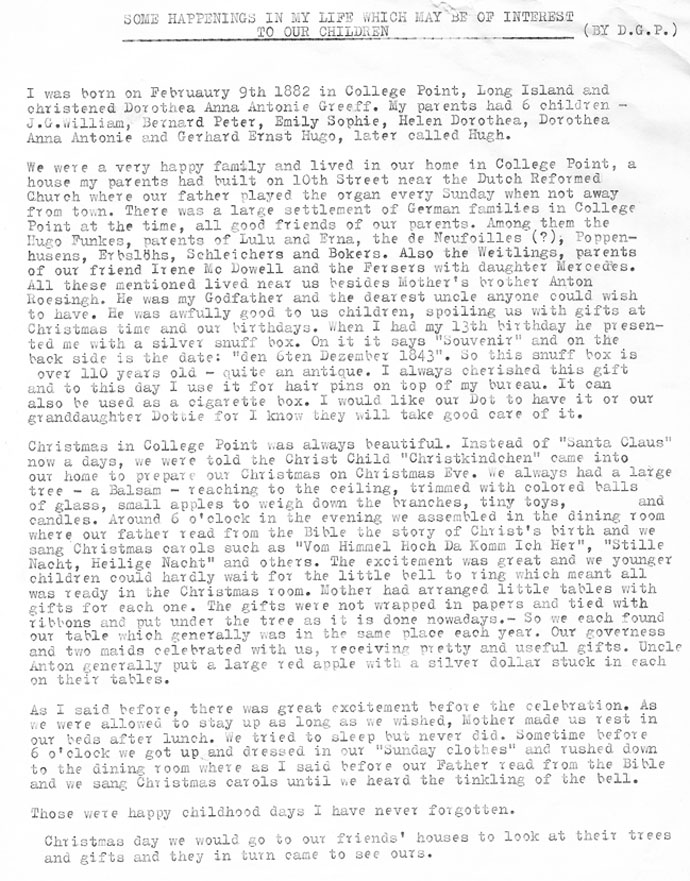
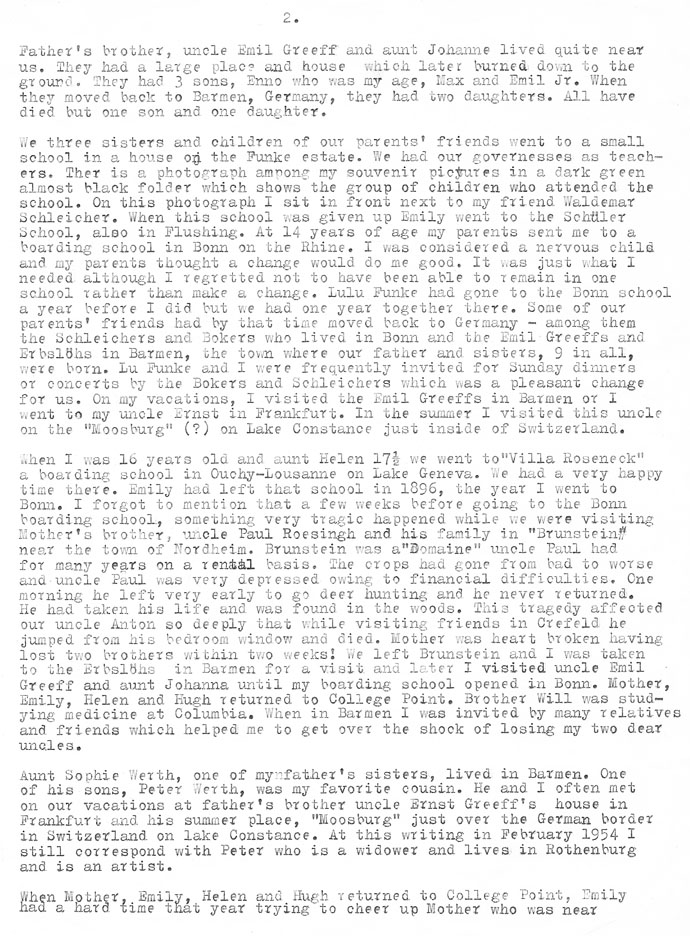
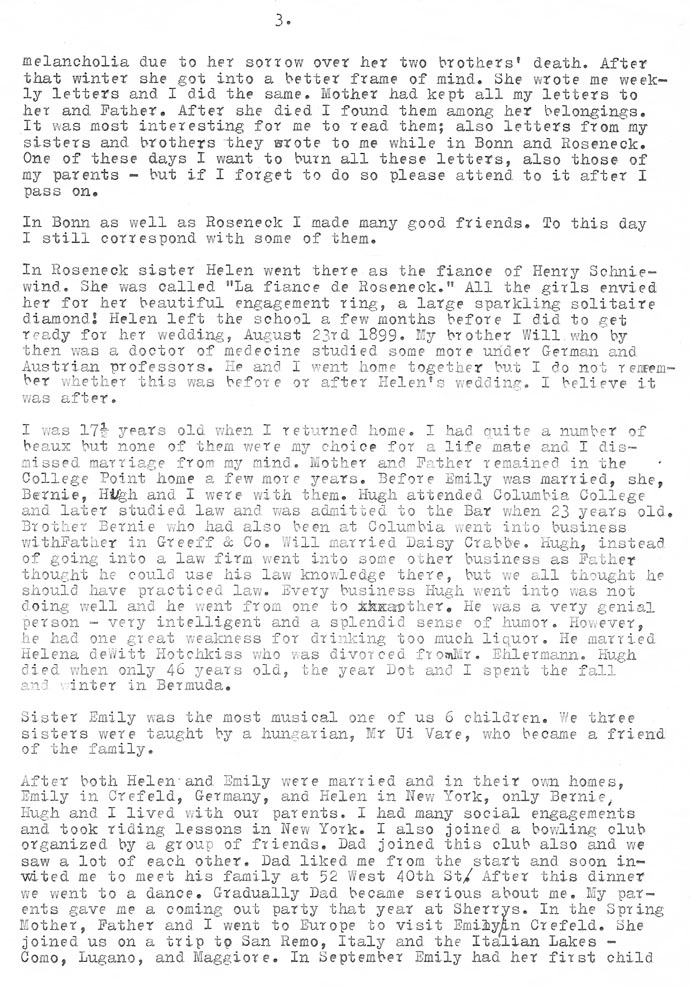
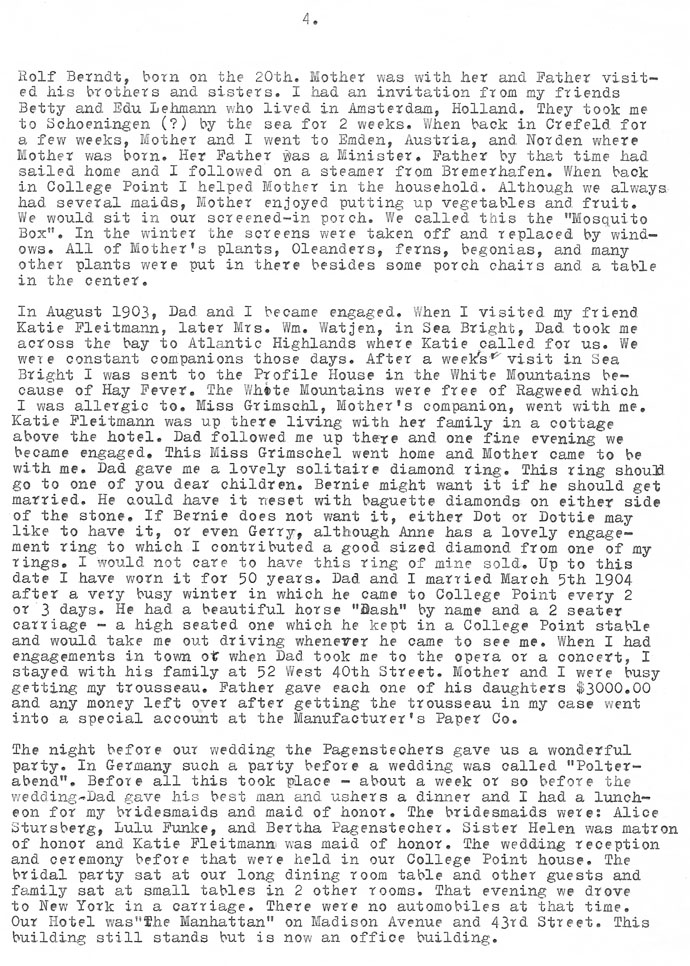

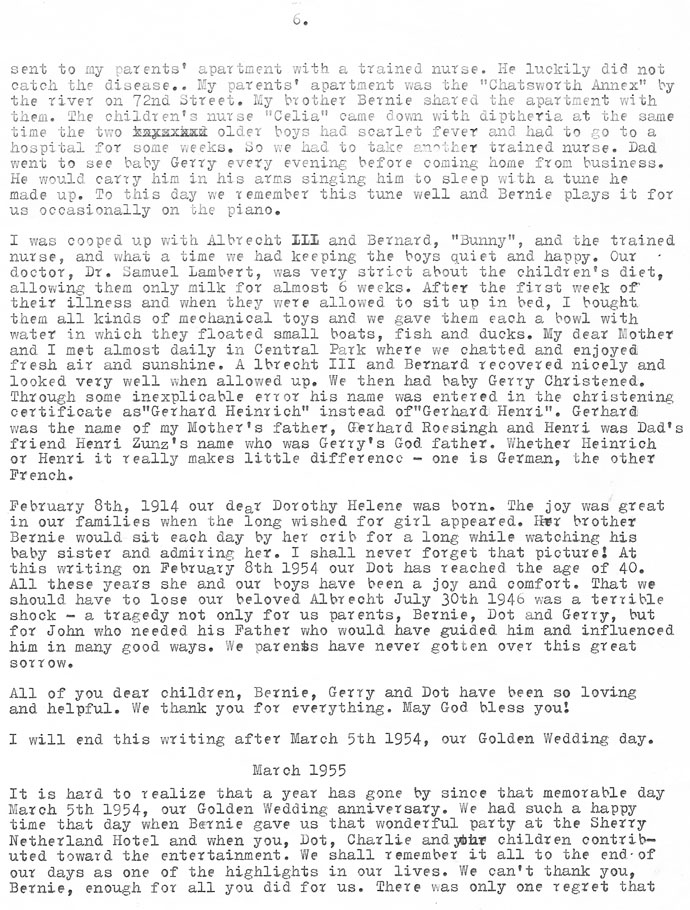
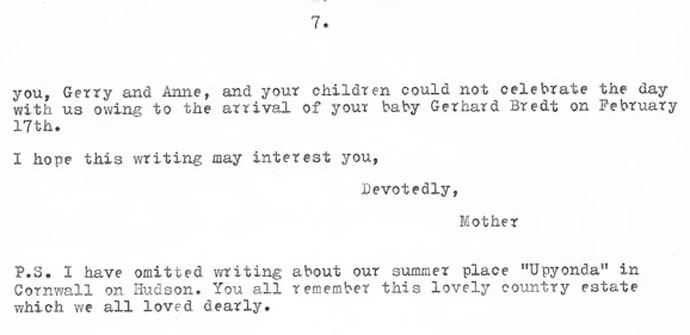
Source:
Dorothea's daughter, Dorothy Pagenstecher, had a granddaughter, Tiffany Smith Hunter (of Newport Beach, California), and it was Tiffany who sent me digital photographs of the original typewritten pages. I am extremely grateful to her for doing so. Thank you very much Tiffany!
Letters and Correspondence
To join the Greeff Correspondence Circle send an email to GREEFF-request@rootsweb.com with just the one word, subscribe, as subject and body of the message. In Afrikaans the Greeff Correspondence Circle is known as "Die Greeff Kuiernet" because it is a forum for all the clan to visit each other and stay in touch, worldwide.
In a letter from Ferdie van Wyk I learned about a genealogical tour to Germany. The purpose of the tour is to conduct genealogical research in Germany. The two is being organised by the Northern Transvaal branch of the genealogical Society of South Africa. The tour organiser is Ellen Harmse. Her email address is eharmse@mweb.co.za.
The tour will take place in September 2009. Prior arrangements will be made for experts to help members of the team with research and translation in Germany. The entire two will be structured around the needs of its individual members. Each participant is asked to nominate three cities at which the tour should call. All in all, it seems like a very worthwhile outing. I think it is important that somebody go along on the tour to represent the Greeff family interests. All the research that has been done so far points clearly to one fact: every single Greeff person in the world seems to have his or her origins in Germany. All of us have a vested interest in the research that can be done on this tour.
This matter is urgent. We must find a delegate to attend the tour immediately. If you are interested in taking part in this tour please contact me as soon as possible. My e-mail address is Greeff@Greeff.info.
Francois Greeff.
*********************
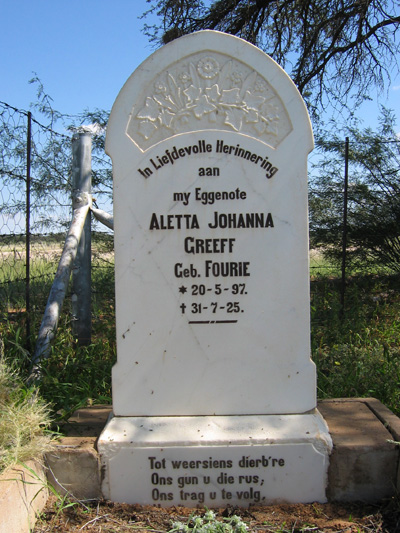
THE GRAVE OF ALETTA GREEFF
AT HOFMEYR, NAMIBIA.
On their recent trip to Namibia Eileen and Marty Russell went to a lot of trouble to photograph Greeff graves. To find the grave of Aletta Johanna Greeff, the first wife of my father Cornelius Johannes Greeff, they had to go right off the beaten track. This is their first report:
"HOFMEYR. We went to Stampriet and started asking where Hofmeyr was, the first person sent us down the road, turn right and you'll find it. We did that but came to a cross roads which was no help at all. Nearby was a school so we went there. None of the kids outside could help so I went indoors and found what appeared to be a staff meeting going on. This was exactly the right place to ask questions - between them they knew the answer - Hofmeyr is a farm and the owner is Mr Lubbe, manager of Stampriet OK Grocer. Mr Lubbe confirmed that there were graves on the farm and when we asked him about Aletta Johanna Greeff he said,"Oh, yes, she's there". He gave us directions, we'd passed it on our way but the farm sign is very small. Mr Lubbe's mother sent a maid to show us the way, beyond the farmhouse is the family graveyard (which we did not have the opportunity to inspect), then up a small hill where there is a pillar bearing German military inscriptions and the foundations of a couple of buildings, 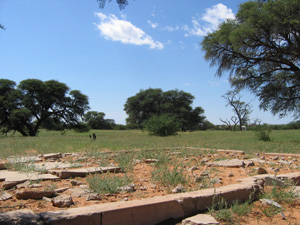 then further on is a fenced cemetery bearing only the usual German military grave notice. Aletta is the sole civilian, she was buried in 1925, the soldiers died in 1904 and 1905 - there must be a story here. They've had a wet summer in Namibia and the grass in the cemetery was long, other than that it is a well kept cemetery, all the stones are in good condition, the fence is in good repair, the gate closes etc. We took photos of Aletta's grave and of the area where the German military buildings once stood. Viljoen's father must have known the area if his first wife was buried there. The farm seemed to consist of low scrub, cattle and ostriches, we're not farmers so there could have been a lot going on that didn't register!" then further on is a fenced cemetery bearing only the usual German military grave notice. Aletta is the sole civilian, she was buried in 1925, the soldiers died in 1904 and 1905 - there must be a story here. They've had a wet summer in Namibia and the grass in the cemetery was long, other than that it is a well kept cemetery, all the stones are in good condition, the fence is in good repair, the gate closes etc. We took photos of Aletta's grave and of the area where the German military buildings once stood. Viljoen's father must have known the area if his first wife was buried there. The farm seemed to consist of low scrub, cattle and ostriches, we're not farmers so there could have been a lot going on that didn't register!"
There is indeed a story there. Hofmeyr was the station for breeding and training camels for the old South West African Police, and my father was stationed there during 1924-25. His young wife died 20 days after giving birth to my brother Johannes Jacobus Greeff and she was buried in the little military cemetery there. The photos show her grave at the rear left corner of the cemetery. She was born Fourie, and we never knew much about her family. We assume that they came from Somerset East, and according to naming conventions her father was probably Johannes Jacobus Fourie. It is highly improbable that any of her immediate family ever saw her grave.
Picture source: Eileen and Marty Russell.
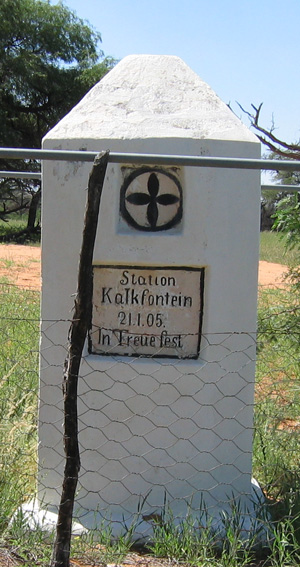 At the turn of the century Namibia was still German South West Africa, and the indigenous tribes, the Herero and the Nama, were starting to revolt against the German rule. A military presence was established with the “Schutztruppen” (protection troops) being sent from Germany. Most of these troops were callow youngsters, and they and their officers were entirely unused to the heat and harsh, dry conditions of Namibia. The previous name of Hofmeyr was Kalkfontein, and the Germans had a military outpost and field hospital there. Late in 1904 the Nama leader Hendrik Witbooi (a man of sufficient education to have kept his diary in High Dutch) rebelled against the Germans and left a trail of blood as farmers were killed on their farms. Women and girls were not harmed, for Witbooi’s order was that only menfolk At the turn of the century Namibia was still German South West Africa, and the indigenous tribes, the Herero and the Nama, were starting to revolt against the German rule. A military presence was established with the “Schutztruppen” (protection troops) being sent from Germany. Most of these troops were callow youngsters, and they and their officers were entirely unused to the heat and harsh, dry conditions of Namibia. The previous name of Hofmeyr was Kalkfontein, and the Germans had a military outpost and field hospital there. Late in 1904 the Nama leader Hendrik Witbooi (a man of sufficient education to have kept his diary in High Dutch) rebelled against the Germans and left a trail of blood as farmers were killed on their farms. Women and girls were not harmed, for Witbooi’s order was that only menfolk 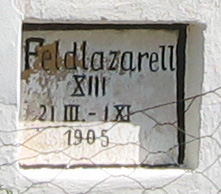 and boys were to be killed. When pursued by German forces, Witbooi fell back to a position at Groß Nabas in the Auob river where there was a strong well. A natural ridge guarding the well was further fortified into a very strong position. In an attempt to get information about their position, major Meister sent out a patrol of 13 men to reconnoiter. The Namas were masters of spying on their enemy and at setting ambushes, and this patrol was waylaid about 13 km from Stampriet and 3km from Groß Nabas. All thirteen were killed. Major Meister then set out with a force of 150 men with a few maxims and two rapid-fire field guns. On the 3rd January 1905 the German force made contact with the Nama force and was unable to dislodge them from their position. They were therefore completely cut off from the only water around. The Namas kept them away from the water until the 6th of January, and only those who have suffered thirst will know what it means to go without water for 3 days in temperatures of around 40 degrees C. and boys were to be killed. When pursued by German forces, Witbooi fell back to a position at Groß Nabas in the Auob river where there was a strong well. A natural ridge guarding the well was further fortified into a very strong position. In an attempt to get information about their position, major Meister sent out a patrol of 13 men to reconnoiter. The Namas were masters of spying on their enemy and at setting ambushes, and this patrol was waylaid about 13 km from Stampriet and 3km from Groß Nabas. All thirteen were killed. Major Meister then set out with a force of 150 men with a few maxims and two rapid-fire field guns. On the 3rd January 1905 the German force made contact with the Nama force and was unable to dislodge them from their position. They were therefore completely cut off from the only water around. The Namas kept them away from the water until the 6th of January, and only those who have suffered thirst will know what it means to go without water for 3 days in temperatures of around 40 degrees C.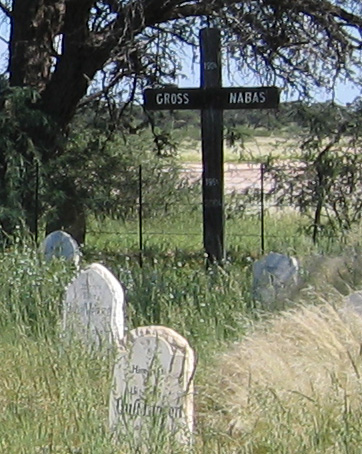 The suffering of the wounded must have been unimaginable. Heart-rending stories are told about this battle, such as that of the trooper who offered his last swallow of red wine to his dying officer, who refused it. Some of the men put fierce biting ants into their mouths in an effort to endure the thirst. All the while the Namas taunted them, flaunting their plentiful supply of water. On the morning of the 6th the thirst-crazed men stormed the Nama postions spontaneously, without any command being given. The weakened men could not advance very fast through the thick sand and suffered heavy losses. More were killed after they had reached the water and could give no thought to anything except slaking their thirst. Altogether 53 men were killed and were buried there, but were later exhumed and re-interred at Hofmeyr. This then is the story of the military graves on Hofmeyr. The suffering of the wounded must have been unimaginable. Heart-rending stories are told about this battle, such as that of the trooper who offered his last swallow of red wine to his dying officer, who refused it. Some of the men put fierce biting ants into their mouths in an effort to endure the thirst. All the while the Namas taunted them, flaunting their plentiful supply of water. On the morning of the 6th the thirst-crazed men stormed the Nama postions spontaneously, without any command being given. The weakened men could not advance very fast through the thick sand and suffered heavy losses. More were killed after they had reached the water and could give no thought to anything except slaking their thirst. Altogether 53 men were killed and were buried there, but were later exhumed and re-interred at Hofmeyr. This then is the story of the military graves on Hofmeyr.
My thanks again to Eileen and Marty. Ever since receiving their lovely photo’s I have found it hard to put it out of my mind. To me there is something extremely poignant about this young wife sharing the small cemetery with the brave Schutztruppen who gave their young lives so many thousands of kilometres from their homeland.
Viljoen Greeff
Heidelberg.
Thanks to Viljoen Greeff and Gerda Pieterse for their efforts in emailing Eileen and Marty Russell's pictures of Hofmeyr to me.
Greeff Farms
A regular column by Natanja Greeff
Anna of Nooitgedacht
Nooitgedacht, in the district of Stellenbosch, was the first farm in South Africa to be occupied by a Greeff family. Matthias Greeff, who arrived at the Cape in 1680, settled there, and married Susanna Claassen four years later, on 12 November 1684. They had nine children, the first of whom, Anna Greeff, was probably born on Nooitgedacht. Anna was baptised 'Antie' on 7 October1685, in the chapel of the Castle at Cape Town, because the first church in South Africa (at Stellenbosch) had not yet been built. The founding and development of Stellenbosch, where Matthias settled in 1680, sets an important background toMatthias' life and decisions. Matthias bought blacksmith's tools from Joost Jansen on leap year's day, 1680. With these tools he set up business in Stellenbosch, at some time in partnership with Johann van Eeden of Oldenburg (Hoge).
"Soon after the Cape of Good Hope had been established, the newly-appointed Governor of the Cape, Simon van der Stel, set out on a discovery journey east to explore the wild and untouched land beyond the Cape Peninsula. On 6 November 1679 he came across a river running through a beautifully green, fertile valley. He named the river "Eerste Rivier" (First River) and the surrounding area "Van der Stel Bosch" (Van der Stel's bush). Before long, news of the finding of this fertile valley spread and the first families settled there in 1680. The settlement later became known as Stellenbosch, and is the second-oldest city in South Africa.
The warm summers and winter rainfall provided an ideal farming environment, and by 1682 the settlement had become an established town. In 1685 it became the seat of a magistrate, whose authority extended over 25 000 square kilometres. The first school was built in 1686, followed soon afterwards by the first church." (Stellenbosch).
Three months after Van der Stel discovered the Eerste river valley Matthias went to live there - pretty much in the middle of nowhere in the uncharted backwoods of remote Africa. Why? Matthias' only marriage, to the12 year old Susanna Claassen, gives one an interesting insight into family relationships in the Cape during the early years, around the year 1700.
(Ball)
(Greeff).
Anna's only marriage is also very revealing:
1. Anna married Burgert Pieterz van Dijk when she was 15 (on 12 Feb 1701).
2. Burgert married Helena (Laina) du Toit after Anna's death.
3. Laina du Toit married Ernst Frederik de Swart after Burgert's death.
4. Ernst Frederik de Swart was a widower, having been married to Catharina Abrahmse.
5. Laina du Toit married Arend Olivier after Ernst died.
6. Laina du Toit married Johannes Botha after Arend died.
7. Johannes Botha was a widower, having been married to Anna van der Merwe. (Rinken)
Anna was thus a part of a group of 7 people who were all related by this chain of marriages.
Anna's husband's wife's husband's wife was Anna.
Anna Greeff x Burgert van Dijk x Laina du Toit x Johannes Botha x Anna van der Merwe.
*************************************
Sources:
1. Rinken, Lucas. Greeff e-SAGI tree at www.Greeff.info
2. Hoge, J. Personalia of Germans at the Cape 1652 - 1806.
3. Stellenbosch. http://www.cape-town.info/surrounding-areas-winelands/stellenbosch
4. Ball, R. Who was Susanna Claassen? http://www.eggsa.org/articles/SusannaClaasz/SusannaClaasz.htm
5. Greeff, F. Matthias Greeff and his Children. http://www.eggsa.org/articles/greeff_children.htm
6. Nooitgedacht Farm - History. http://www.nooitgedachtestate.co.za/site/awdep.asp?depnum=14972
For further information about the seven marriages, enter the names in the list of marriages into the search function on the Greeff Family Web site:
http://www.greeff.info/tng01/searchform.php
Gerhardus Jacobus Greeff of Steenkampsberg.
Annemarie Folkus sent in this map in May, and I still want to know who this man was, and how he fits into the Greeff family. If you know anything about him, please email Francois at Greeff@Greeff.info.
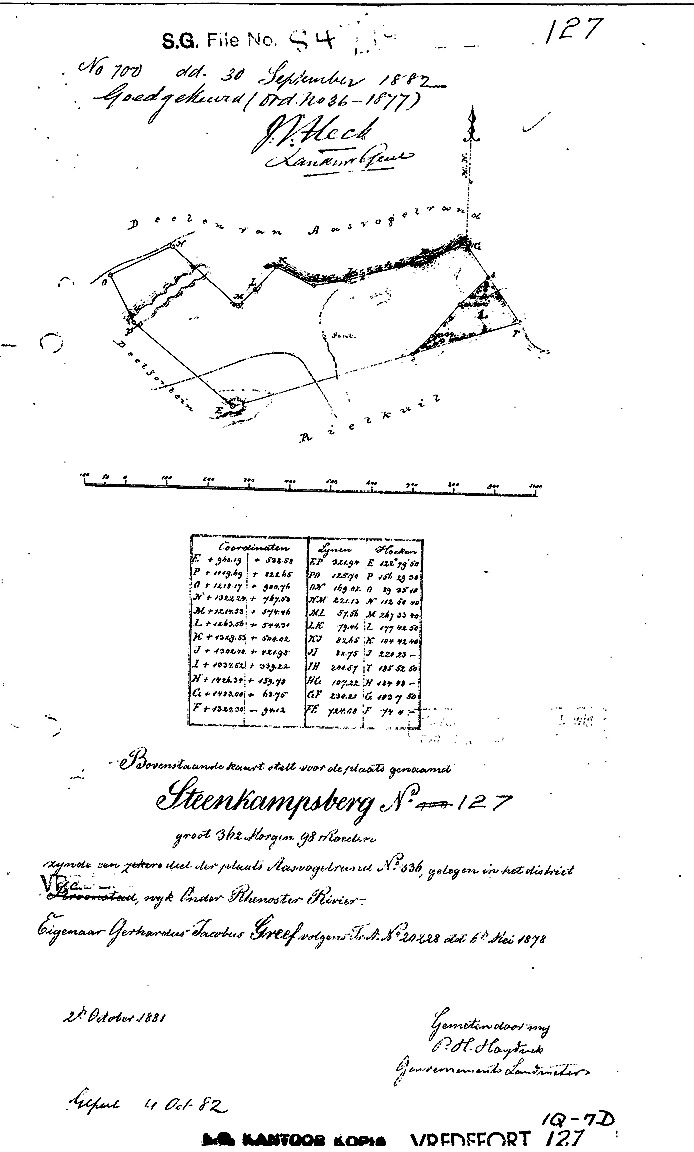
Document source: SA Deeds Office. Photo: Thanks to Annemarie Folkus.
Vacancies, Jobs and Volunteers
Research positions in the Greeff Family Research.
1. Paid Work
I have decided to offer several part time jobs to scholars, housewives and retired people in South Africa. I will pay all applicants One Rand for every photo they add to the Greeff Family Tree. The work is dead easy, and all you need is a computer, broadband and a bit of common sense. I will show you how to attach, at first, your own photos to your family records on the Greeff website. After that I will send you more photos from the thousands of records I hold on my computer. The aim is to get the entire Greeff family tree supported by photos, as, for example at:
http://www.greeff.info/tng01/pedigree.php?personID=I2&tree=GreeffKwartierstaat
Please email Francois Greeff at Greeff@Greeff.info if you are interested in this highly satisfying work.
2. Volunteer Researcher to visit Germany
A group of people from South Africa will be visiting Germany in September 2009, as part of an organised Family History Research Tour, offered by the Northern Transvaal branch of the Genealogical Society of South Africa. I will personally pay the membership fees for each Greeff volunteer who joins the tour to become a member of the branch for a full year. The tour will be organised to accommodate the individual needs of the participants, and experts in Germany will assist in research and with translation. Arrangements will be made in advance to notify the appropriate research facilities of information and documents that will be needed. At least one volunteer, from any part of the world, is urgently needed to represent the Greeff family in this group. Ideally, three or four representatives would be best, so that different people can focus on different research areas, each of which is a big and important task. I can immediately think of Four major areas that need to be researched in Germany:
1. Matthias Greeff and his ancestors
2. Friedrich Greeff and his ancestors
3. Hugo Greeff and the ancestors of the Greeff family in America
4. The Greeff family in Germany generally - finding and contacting living Greeff people, photographing Greeff graves, church records, and and Greeff documents from archival repositories in Germany.
It makes much sense for us to try to include a descendant of Matthias Greeff, a descendant of Friedrich Greeff, and a descendant of Hugo Greeff.
This excusion offers a pleasant holiday in Germany, and is ideal for retired folk.
|









 then further on is a fenced cemetery bearing only the usual German military grave notice. Aletta is the sole civilian, she was buried in 1925, the soldiers died in 1904 and 1905 - there must be a story here. They've had a wet summer in Namibia and the grass in the cemetery was long, other than that it is a well kept cemetery, all the stones are in good condition, the fence is in good repair, the gate closes etc. We took photos of Aletta's grave and of the area where the German military buildings once stood. Viljoen's father must have known the area if his first wife was buried there. The farm seemed to consist of low scrub, cattle and ostriches, we're not farmers so there could have been a lot going on that didn't register!"
then further on is a fenced cemetery bearing only the usual German military grave notice. Aletta is the sole civilian, she was buried in 1925, the soldiers died in 1904 and 1905 - there must be a story here. They've had a wet summer in Namibia and the grass in the cemetery was long, other than that it is a well kept cemetery, all the stones are in good condition, the fence is in good repair, the gate closes etc. We took photos of Aletta's grave and of the area where the German military buildings once stood. Viljoen's father must have known the area if his first wife was buried there. The farm seemed to consist of low scrub, cattle and ostriches, we're not farmers so there could have been a lot going on that didn't register!"
 and boys were to be killed. When pursued by German forces, Witbooi fell back to a position at Groß Nabas in the Auob river where there was a strong well. A natural ridge guarding the well was further fortified into a very strong position. In an attempt to get information about their position, major Meister sent out a patrol of 13 men to reconnoiter. The Namas were masters of spying on their enemy and at setting ambushes, and this patrol was waylaid about 13 km from Stampriet and 3km from Groß Nabas. All thirteen were killed. Major Meister then set out with a force of 150 men with a few maxims and two rapid-fire field guns. On the 3rd January 1905 the German force made contact with the Nama force and was unable to dislodge them from their position. They were therefore completely cut off from the only water around. The Namas kept them away from the water until the 6th of January, and only those who have suffered thirst will know what it means to go without water for 3 days in temperatures of around 40 degrees C.
and boys were to be killed. When pursued by German forces, Witbooi fell back to a position at Groß Nabas in the Auob river where there was a strong well. A natural ridge guarding the well was further fortified into a very strong position. In an attempt to get information about their position, major Meister sent out a patrol of 13 men to reconnoiter. The Namas were masters of spying on their enemy and at setting ambushes, and this patrol was waylaid about 13 km from Stampriet and 3km from Groß Nabas. All thirteen were killed. Major Meister then set out with a force of 150 men with a few maxims and two rapid-fire field guns. On the 3rd January 1905 the German force made contact with the Nama force and was unable to dislodge them from their position. They were therefore completely cut off from the only water around. The Namas kept them away from the water until the 6th of January, and only those who have suffered thirst will know what it means to go without water for 3 days in temperatures of around 40 degrees C.
